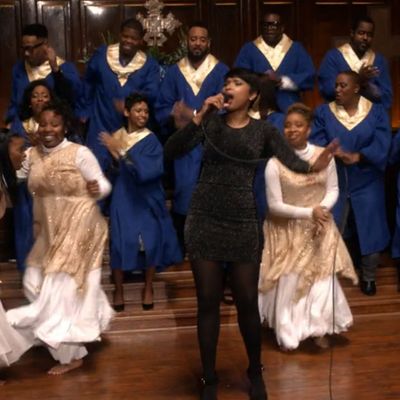
Embedded in Empire’s over-the-top story lines and mic-drops are its sincere musical performances. Originally, the season’s final two hours were shot as two separate episodes, 11 and 12. The first hour (Episode 11, “Die But Once”) focuses on the themes of death, resurrection, belief, and betrayal. Jennifer Hudson, who plays Andre’s music therapist, Michelle, closes the episode with a gospel number that brings the church down. Speaking to Vulture, Empire’s choreographer, John Carrafa, who’s played himself on several episodes, broke down how he brought the sprawling church event onto the screen.
How did you bring Jennifer Hudson’s performance from what you read in the script onto the screen?
Wendy Calhoun, one of the writers, introduced me to this world of liturgical dancers, which I really didn’t know much about. So I started researching it way before we got the script. There’s a piece called “Revelations” that Alvin Ailey did that was sort of a faith-based dance, and I thought about a combination of Ailey and liturgical. Every mini-step is carefully orchestrated. I didn’t work with Jennifer until a few hours before. We all had the recording of Jennifer to rehearse to. When Jennifer was done with her other scenes, we got her, the dancers, and the choir — about 22 people — all together in a little room in the back of the church while the 1,200 people in the congregation of the church assembled. I walked Jennifer through her blocking. She’s a pro, so that’s a breeze for her, and she already knew the song, “For My God,” and we kept it from the crowd. So their real reaction was what we were able to film. The first time we did it with Jennifer — it was like a bomb went off in that theater.
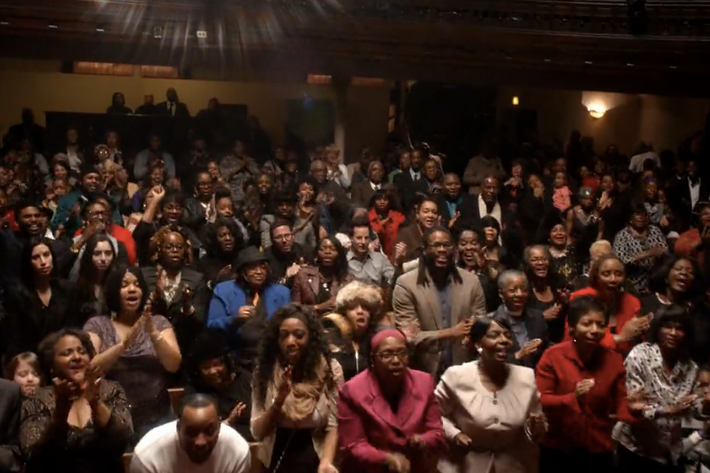
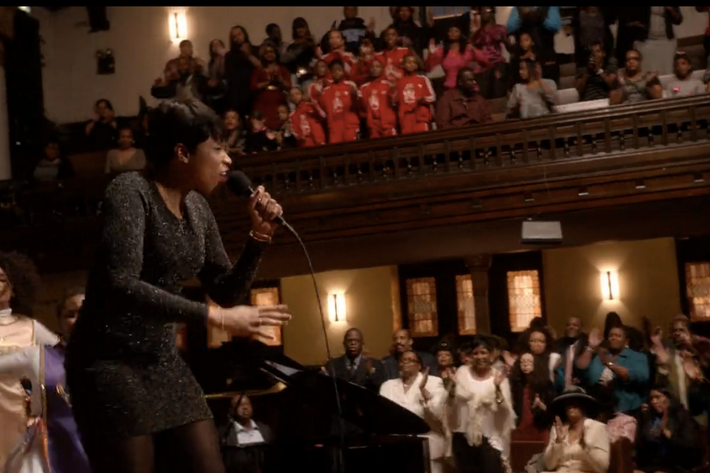
What’s fun about this event is that nobody was faking it. Everybody involved — it’s all about faith. Jennifer Hudson, that’s very important to her — we used a real gospel choir, and the liturgical dancers were people from churches that auditioned. The Metropolitan Apostolic Community Church, where we filmed, was filled with the real congregation. Often in these situations you have extras and say, “Clap here,” but this was a real event. People in the church were legitimately inspired and moved and losing their minds.
How do you go about creating the movements we see onstage?
So the lyrics are, “There ain’t nothing too hard for my God.” In liturgical dance vocabulary, there are movements like praising God, movements up to God. I made up steps where they could lose themselves and also express their faith and joy and the power of that, like raising their arms. I do a [Martha] Graham hinge, which is basically falling onto your back from a standing position without putting your hands down, like you’ve been overcome with the Spirit.
There’s a place where the music peaks that feels like just completely — the abandon of faith and spirit. There’s a moment where the music does this Whoa whoa whoa whoa whoa whoa, where it kind of goes into the stratosphere, right? So I had the dancers grab each other so it kind of became like water. It’s funny, because it’s a really modern-dance-y thing — it’s an unusual move, it’s kind of my trademark kind of thing, where they’re kind of moving around, flying around, and I had the choir mirror it with them. You know if you’re at a club and you’re dancing and you get to a moment that’s like a peak moment and you start rocking out like crazy? That’s that. It kind of allowed them to lose their minds. Out of the stuff, they started spinning and jumping … kind of constructing something like a rave, lose themselves, be overcome with the power of their faith. That’s the incredible thing that happens to them in church.
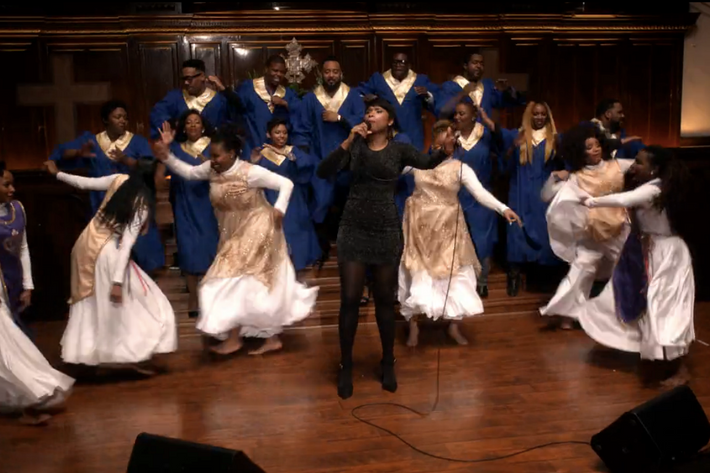
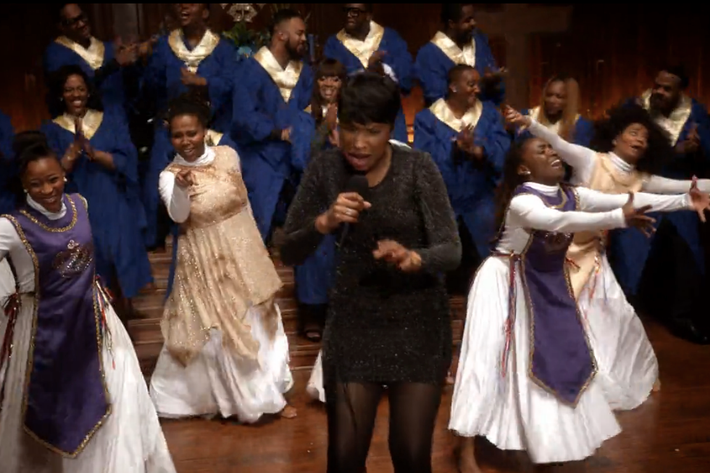
That moment where the dancers are “losing their minds,” that’s like freestyling or improvising?
No, it relates to how you or I would freestyle in a club, but what it was for them, it was a very specific piece of choreography where all those six women put their hands around each other and became one giant wave. It’s funny, I took that out but the dancers were like, “No, that’s good. That’s like nothing we’ve done before. We get into it.” So I kept it in. They grab each other and they’re holding each other, and the six of them are doing a giant wave. And at the same time, I said, “Choir, you do that, too.” Everybody’s doing this wave thing, and it’s the section of the song that sends Jennifer into the peak finale.
How much did you choreograph Jennifer Hudson?
She’s not a big mover, it’s not like you think, Oh, Jennifer Hudson, big dance performer. It’s about her presence. I walked her through the choreography and showed her where to move, and she did it in two seconds. It was pretty simple. Basically I staged it with the other people so there’s spaces for her. Because often with the stars, you get very, very little time, if any time. So I built it so that she could just plop right into it. It’s often the case the soloist singer will relate to the choir director; they’re like a team. Then, when the dancers come up, the choir director moves and directs the choir from the side. And Jennifer moved down and the dancers surrounded Jennifer. Because the first part was about the dancers, right? She performs a song and sometimes sings to the choir director as well as the congregation, because he’s standing next to her, then will step down and just sing to the congregation.
But who makes those decisions, who she’s facing, etc.? That’s all organic, isn’t it?
That’s me. One thing I’m proud of is I make these things look like they weren’t made up by a choreographer. Because you can tell if someone says, “Jennifer, step downstage here.” I show her what I’m doing, but I also have a looseness to it so it looks like she’s making it up on the spot. I don’t say, “On this count, step here.” It’s funny, because some actors really wish they had that. They’ll say, “Just tell me where to go.” But it really works better if they feel like it was their idea. So I give them the space, but I lead them in the direction I want them to go. There are instances — I just did Christina Aguilera [for Nashville] — where you want it to look choreographed. But most of what I like to do is make it look like a real event. That’s why I love this thing at Empire. I put the puzzle together and choreographed that water move in a way I hoped would get people super excited and lose their minds. It’s “How do you build excitement on a stage?” versus “How do you create clever steps?”
You storyboard it?
I storyboard it, but out of sequence. I’ll listen to the music like 5,000 times, then I’ll go, “I think I see something like this. Something like a wave thing.” There’s 50 ideas I have that don’t make it on the show. What’s fascinating about choreogrpahy is you get images in your head and you think it looks amazing, and then you do it on an actually human body and it’s like, “That doesn’t work at all. You can’t actually do that physically.” As many years as I’ve been choreographing, every time I imagine something, it’s so different from the reality. That happens every time you make a dance. Unless you use your old tricks, but I don’t like to do that. I try to do something new all the time. And then you go in there and you get inspired by the people. If it was six different people, it would’ve been a different dance.
How is working with Jennifer versus working with other people in that situation?
Her background, how she came up and all the training she had on American Idol, you see all that experience and training — that she was put through this farm system of singers. It reminded me, in a funny way, completely different, but I worked with Vanessa Williams when I did Into the Woods. And Vanessa Williams came up in the pageant world. You could see there was this training she had being a pageant person that always would be with her when she did a song or how she understood staging or how she would learn. She was influenced by that very much. I’m working with Clive Owen on The Knick next week. Everybody is so different. That’s what’s been interesting to me about doing this.
You also work on Nashville. What is there to choreograph on that show? I don’t associate it with big dance numbers.
I work with actors, and I help create a character through movement and physicality. In Nashville’s case, it’s Connie Britton playing Rayna James, this country singer. Not just playing a generic singer, but, what’s Rayna James’s thing when she performs as a singer? When singers sing onstage, what is their focus on? When actors play a singer onstage, they’re usually emoting the song in a way that singers don’t. Because singers, more than anything, are listening to the sound and listening to themselves. They’re telling a story, but not the same way actors tell a story. So I told Connie, “Put your attention on the song and the voice, and then they’ll buy that you’re a singer. Then you’ll be doing what singers do. Don’t put your attention on acting like a singer.”
So Connie became Rayna James. There’s little things she does with her hands that we decided are Rayna James trademarks. For example, in every big number, she raises her arm and points to the sky. That’s the Rayna James arm thing.
What was it like being on set while this big number is filming?
The vibe on Empire — it is such a family, the crew and the cast, everybody feels passionately and heartfelt about it. This church thing, the crew was clapping their hands and singing, and also the actors that weren’t in the scene. It was just this great, collaborative thing. Then Terrence Howard came into the back of the church partway though the day, and the congregation was all there. It was like Obama had shown up. It was Jay Z, rock star, the-biggest-star-you-can-imagine big. People just mobbed him. It took a while to calm the crowd down and get everybody back onstage. And Terrence is such the daddy of our whole team, so it was such a great, funny, fun thing. People just wanted to touch him.

